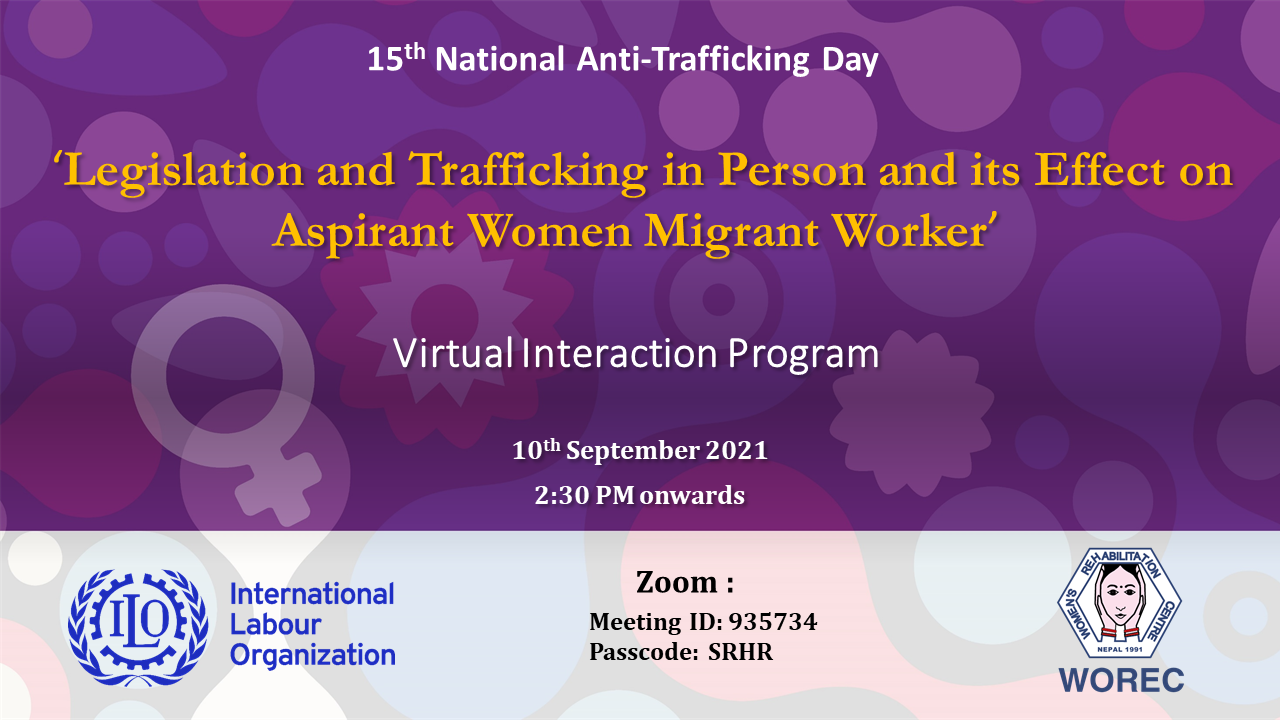
Interaction Program on
Legislation and Trafficking in Person and its effect on aspirant women migrant worker
(On the Occasion of World Day Against Trafficking in Persons)
Background:
At the global level, it is recorded in 2018 about 50,000 human trafficking victims were detected and reported by 148 countries. About 50%of detected victims were trafficked for sexual exploitation, 38% were exploited for forced labor. Female victims continue to be the primary targets. Women make up 46% and girls 19% of all victims of trafficking[1]..
In the present context in Nepal, human traffickers exploit domestic and foreign victims while traffickers exploit Nepali victims abroad. Sex traffickers exploit Nepali women and girls in Nepal, India, West Asia, Malaysia, and—to a lesser extent—other Asian countries and Sub-Saharan Africa, including Kenya. Traffickers use Nepal’s open border with India to transport Nepali women and children to India for sex trafficking, including under the guise of “orchestra dancers,” where girls dance at public functions and men sexually exploit them. The Government of Nepal (GoN) estimates approximately 1.5 million Nepali migrant workers work in the Middle East, with the vast majority of men in construction in Saudi Arabia, Qatar, and UAE. Due to the Government of Nepal’s restrictive policies/procedures on domestic workers’ formal migration to Arab countries, Malaysia and Lebanon, many women Nepali domestic workers tend to travel to Countries of destinations (CoDs) through informal channels, which increases their vulnerability to trafficking and forced labor [2]. The lack of safe and legal migration opportunities and the general demand for unskilled, cheap, and exploitative labor combined with the lack of legal protection, exposes large groups of people to a considerable risk of exploitation and abuse.
Migration and trafficking can be confusing topics. Migration, or movement, is an element of trafficking, as are coercion and exploitation. Because of this connection, many people working on anti-trafficking have been concerned with larger migration issues for a long time. While the connection exists in practice and some advocates have been working at this intersection, migration, and trafficking are often kept separate – as separate concepts, as separate policies, and as separate social movements. Still, there is a thin nexus between these two phenomena.
A punitive approach often leads to the confusion of trafficking with migration and of trafficking with trafficking for sex work. However, it is pertinent to recognize migration as an important livelihood strategy that occurs in varied work sectors, including construction, domestic work, the textiles and garment industries, and such. Moreover, when migration is accompanied by deception and forced labor, as in the case of trafficking, it is not due to ‘organized crime’ but structural vulnerabilities including migrants’ gender, caste and religion, weak regulatory frameworks, selective law enforcement, and gender-insensitive migration policies. Though most anti-trafficking legislation and measures have good intentions, they can work against the people they are trying to help. Therefore, overuse of the trafficking category is not helpful, if it results in rights restrictions and “collateral damage” for broader groups of people such as women who move. All in all, it is also important to ask governments for policy consistency in dealing with the issues of migration for labor employment, and trafficking.
As elsewhere, legislation and policies in Nepal remain strongly rooted in a criminal approach with little attention paid to the human rights dimension. We feel that this discussion is urgently needed, particularly considering the COVID-19 pandemic, which in Nepal and India has shown cases of increase in trafficking in person. Meanwhile, India has recently published the Trafficking in Persons (Prevention, Care and Rehabilitation) Bill, 2021 proposed to be introduced by the Ministry of Women and Child Development in the monsoon session of the Indian Parliament.
This program is conducted as a part of the advocacy activities of the organizers for the celebration of World Day Against Trafficking in Persons- 30 July. The World Day against Trafficking in Persons was proclaimed by the United Nations General Assembly, in its resolution A/RES/68/192.
Objective:
The two-hour program is aimed to
Output:
Program Agenda
Date: 10 September 2021 (Friday)
Time: 2:30 pm onwards
Online Zoom Platform
Zoom Meeting ID: 935734
Password: SRHR
https://zoom.us/j/9357349827?pwd=RVMzRzRGZnpLYnRqK3dsVmhuKzJMZz09
Participants list
1. ILO Nepal
2. Shakti Samuha
3. AATWIN
4. People’s Forum
5. Maiti Nepal
6. Paurakhi
7. MOWSC
8. MOLESS
9. NHRC
10. NWC
11. AMKAS
12. WOREC
13. ABC Nepal
14. FWLD
15. Tarangini
16. WOFOWON
17. NAWHRD
18. NNSM
19. LAAC Nepal
20. CWISH
21. Tewa
22. CESLAM
23. IDWF
24. SARTUC
25. Care Nepal
26. Plan International
27. Helvetas
28. Amnesty International
29. WINROC
30. UN Women
31.FCDO
32. USAID/SDC